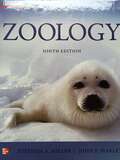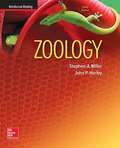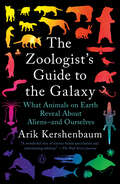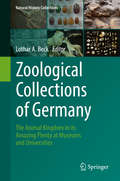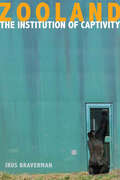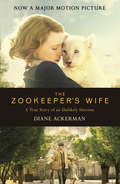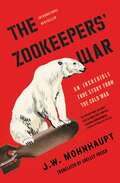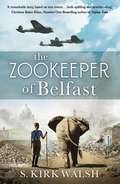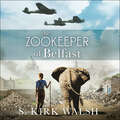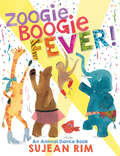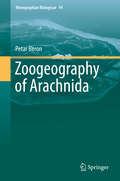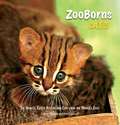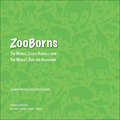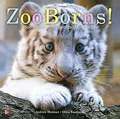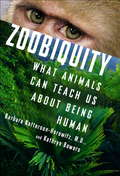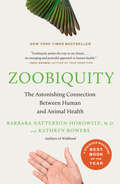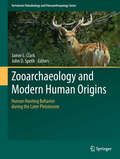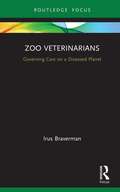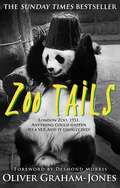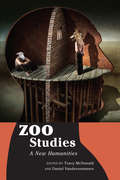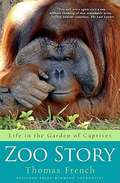- Table View
- List View
Zoology
by Stephen A. Miller John P. HarleyThe new 7th edition of "Zoology" continues to offer students an introductory general zoology text that is manageable in size and adaptable to a variety of course formats. It is a principles-oriented text written for the non-majors or the combined course, presented at the freshman and sophomore level. "Zoology" is organized into three parts. Part One covers the common life processes, including cell and tissue structure and function, the genetic basis of evolution, and the evolutionary and ecological principles that unify all life. Part Two is the survey of protists and animals, emphasizing evolutionary and ecological relationships, aspects of animal organization that unite major animal phyla, and animal adaptations. Part Three covers animal form and function using a comparative approach. This approach includes descriptions and full-color artwork that depict evolutionary changes in the structure and function of selected organ systems.
Zoology
by Stephen A. Miller John P. HarleyThe new 7th edition of "Zoology" continues to offer students an introductory general zoology text that is manageable in size and adaptable to a variety of course formats. It is a principles-oriented text written for the non-majors or the combined course, presented at the freshman and sophomore level. "Zoology" is organized into three parts. Part One covers the common life processes, including cell and tissue structure and function, the genetic basis of evolution, and the evolutionary and ecological principles that unify all life. Part Two is the survey of protists and animals, emphasizing evolutionary and ecological relationships, aspects of animal organization that unite major animal phyla, and animal adaptations. Part Three covers animal form and function using a comparative approach. This approach includes descriptions and full-color artwork that depict evolutionary changes in the structure and function of selected organ systems.
The Zoologist's Guide to the Galaxy: What Animals on Earth Reveal About Aliens--and Ourselves
by Arik KershenbaumFrom a noted Cambridge zoologist, a wildly fun and scientifically sound exploration of what alien life must be like, using universal laws that govern life on Earth and in space.Scientists are confident that life exists elsewhere in the universe. Yet rather than taking a realistic approach to what aliens might be like, we imagine that life on other planets is the stuff of science fiction. The time has come to abandon our fantasies of space invaders and movie monsters and place our expectations on solid scientific footing.But short of aliens landing in New York City, how do we know what they are like? Using his own expert understanding of life on Earth and Darwin's theory of evolution--which applies throughout the universe--Cambridge zoologist Dr. Arik Kershenbaum explains what alien life must be like: how these creatures will move, socialize, and communicate. For example, by observing fish whose electrical pulses indicate social status, we can see that other planets might allow for communication by electricity. As there was evolutionary pressure to wriggle along a sea floor, Earthling animals tend to have left/right symmetry; on planets where creatures evolved in midair or in soupy tar, they might be lacking any symmetry at all.Might there be an alien planet with supersonic animals? A moon where creatures have a language composed of smells? Will aliens scream with fear, act honestly, or have technology? The Zoologist's Guide to the Galaxy answers these questions using the latest science to tell the story of how life really works, on Earth and in space.
Zoological Collections of Germany: The Animal Kingdom in its Amazing Plenty at Museums and Universities
by Lothar A. BeckProvides a timely compilation of German zoological collections.<P><P> Casts new light on endangered zoological collections and explores modern exhibition concepts.<P> Maximizes readers insight into the zoological collection network.<P> This book is devoted to the knowledge of up to 250 years of collecting, organizing and preserving animals by generations of scientists. Zoological Collections are a huge resource for modern animal research and should be available for national and international scientists and institutions, as well as prospective public and private customers. Moreover, these collections are an important part of the scientific enterprise, supporting scientific research, human health, public education, and the conservation of biodiversity. Much of what we are beginning to understand about our world, we owe to the collection, preservation, and ongoing study of natural specimens. Properly preserved collections of marine or terrestrial animals are libraries of Earth's history and vital to our ability to learn about our place in its future.<P> The approach employed by the editor involves not only an introduction to the topic, but also an external view on German collections including an assessment of their value in the international and national context, and information on the international and national collection networks. Particular attention is given to new approaches of sorting, preserving and researching in Zoological Collections as well as their neglect and/or threat. In addition, the book provides information on all big Public Research Museums, on important Collections in regional Country and local District Museums, and also on University collections.<P> This is a highly informative and carefully presented book, providing scientific insight for readers with an interest in biodiversity, taxonomy, or evolution, as well as natural history collections at larg
Zooland: The Institution of Captivity
by Irus BravermanThis book takes a unique stance on a controversial topic: zoos. Zoos have their ardent supporters and their vocal detractors. And while we all have opinions onwhatzoos do, few people considerhowthey do it. Irus Braverman draws on more than seventy interviews conducted with zoo managers and administrators, as well as animal activists, to offer a glimpse into the otherwise unknown complexities of zooland. Zoolandbegins and ends with the story of Timmy, the oldest male gorilla in North America, to illustrate the dramatic transformations of zoos since the 1970s. Over these decades, modern zoos have transformed themselves from places created largely for entertainment to globally connected institutions that emphasize care through conservation and education. Zoos naturalize their spaces, classify their animals, and produce spectacular experiences for their human visitors. Zoos name, register, track, and allocate their animals in global databases. Zoos both abide by and create laws and industry standards that govern their captive animals. Finally, zoos intensely govern the reproduction of captive animals, carefully calculating the life and death of these animals, deciding which of them will be sustained and which will expire. Zoolandtakes readers behind the exhibits into the world of zoo animals and their caretakers. And in so doing, it turns its gaze back on us to make surprising interconnections between our understandings of the human and the nonhuman.
The Zookeeper's Wife: An unforgettable true story, now a major film (Movie Tie-in Editions Ser. #0)
by Diane AckermanIn war-torn Warsaw, a zookeeper and his wife refuse to surrender... Now a major motion picture starring Jessica Chastain and Daniel Brühl, Diane Ackerman's The Zookeeper's Wife is based on a remarkable true story of bravery and sanctuary during World War II. Perfect for fans of Lion and Hidden Figures. 'I can't imagine a better story or storyteller. The Zookeeper's Wife will touch every nerve you have' -Jonathan Safran Foer, author of Everything is Illuminated When Germany invades Poland, Luftwaffe bombers devastate Warsaw and the city's zoo along with it. With most of their animals killed, or stolen away to Berlin, zookeepers Jan and Antonina Zabinski begin smuggling Jews into the empty cages.As the war escalates Jan becomes increasingly involved in the anti-Nazi resistance. Ammunition is buried in the elephant enclosure and explosives stored in the animal hospital. Plans are prepared for what will become the Warsaw uprising. Through the ever-present fear of discovery, Antonina must keep her unusual household afloat, caring for both its human and animal inhabitants - otters, a badger, hyena pups, lynxes - as Europe crumbles around them.Written with the narrative drive and emotional punch of a novel, The Zookeeper's Wife is a remarkable true story. It shows us the human and personal impact of war - of life in the Warsaw Ghetto, of fighting in the anti-Nazi resistance. But more than anything it is a story of decency and sacrifice triumphing over terror and oppression. What readers are saying about The Zookeeper's Wife: 'Beautifully and sensitively written - a must read''An adventure that inspires''Both horrifying and endearing on a scale I've not experienced in years''A story that will haunt you forever''Haunting, life affirming, sad, and inspiring'
The Zookeepers' War: An Incredible True Story from the Cold War
by J.W. MohnhauptTHE ACCLAIMED INTERNATIONAL BESTSELLER The unbelievable true story of the Cold War&’s strangest proxy war, fought between the zoos on either side of the Berlin Wall.Living in West Berlin in the 1960s often felt like living in a zoo, everyone packed together behind a wall, with the world always watching. On the other side of the Iron Curtain, the East Berlin zoo was spacious and lush, a socialist utopia where everything was perfectly planned...and then rarely successfully finished. Berlin&’s two zoos quickly became symbols of the divided city&’s two halves. And so no one was terribly surprised when the head zookeepers on either side started an animal arms race—rather than stockpiling nuclear warheads, competing to have the most pandas and hippos. Soon, state funds were being quietly diverted to give these new animals lavish welcomes worthy of visiting dignitaries. West German presidential candidates were talking about zoo policy on the campaign trail. And eventually politicians on both side of the Wall became convinced that if their zoo were proved to be inferior, then that would mean their country&’s whole ideology was too. A quirky piece of Cold War history unlike anything you&’ve heard before, The Zookeepers&’ War is an epic tale of desperate rivalries, human follies, and an animal-mad city in which zookeeping became a way of continuing politics by other means.
The Zookeeper of Belfast: A heart-stopping WW2 historical novel based on an incredible true story
by S. Kirk WalshAs the bombs rain down on the city, Belfast's first ever female zookeeper must fight to save the baby elephant in her charge in this gripping, uplifting tale based on a true story.1941. With the men away fighting, animal-lover Hettie Quin is made Belfast Zoo's first ever female zookeeper. She is put in charge of Violet, a three-year-old Indian elephant, and they soon form a special bond. With Violet at her side, Hettie can almost escape the grim reality of her life: the father who has abandoned her family; the sister who recently died; the war that's raging hundreds of miles away.But the devastation of war is closer than she thought. When the bombs begin to rain down on the city, Hettie must gather all her courage to protect those she loves the most. Can she save Violet - and get through unscathed herself?Based on a true story, The Zookeeper of Belfast is a gripping and uplifting tribute to what one woman's courage and tenacity can achieve in the most dire of circumstances - perfect for fans of Heather Morris, Natasha Lester, Kate Furnivall, Mandy Robotham and Fiona Valpy.Praise for THE ZOOKEEPER OF BELFAST:'Walsh delivers a turbulent portrait of life in a divided city . . . A unique perspective of a country at war and the lengths people will go for those they love.' - Kirkus Reviews'Sensitively rendered and finely drawn, this remarkable story, based on true events, is both uplifting and heartbreaking.' - Christina Baker Kline, #1 New York Times bestselling author of Orphan Train'Walsh has written a novel of deep affection and knife-edge suspense. A brilliant debut.' - Margot Livesey, author of The Boy in The Field'An elephant, a young zookeeper, the city of Belfast, bombings, and an IRA member are the improbable characters in this captivating and intimately felt novel that tells the story of a young woman's uncommon devotion and courage under fire.' - Lily Tuck, author of Sisters'A zoo in wartime Belfast and a young woman's fierce love for the elephant in her care come vividly to life in this beautiful, beguiling, and atmospheric debut novel.' - Dominic Smith, author of The Last Painting of Sara de Vos·Cinematic in scope and brimming with emotion, this is a soaring work of historical imagination.' - Karen Olsson, author of All the Houses
The Zookeeper of Belfast: A heart-stopping WW2 historical novel based on an incredible true story
by S. Kirk WalshA stunning World War Two novel for fans of Natasha Lester, Heather Morris, Kate Furnivall, Mandy Robotham, based on a true story.As the bombs rain down on the city, Belfast's first ever female zookeeper must fight to save the baby elephant in her charge in this gripping, uplifting tale based on a true story.1941. With the men away fighting, animal-lover Hettie Quin is made Belfast Zoo's first ever female zookeeper. She is put in charge of Violet, a three-year-old Indian elephant, and they soon form a special bond. With Violet at her side, Hettie can almost escape the grim reality of her life: the father who has abandoned her family; the sister who recently died; the war that's raging hundreds of miles away.But the devastation of war is closer than she thought. When the bombs begin to rain down on the city, Hettie must gather all her courage to protect those she loves the most. Can she save Violet - and get through unscathed herself?Based on a true story, The Zookeeper of Belfast is a gripping and uplifting tribute to what one woman's courage and tenacity can achieve in the most dire of circumstances - perfect for fans of Heather Morris, Natasha Lester, Kate Furnivall, Mandy Robotham and Fiona Valpy.Praise for THE ZOOKEEPER OF BELFAST:'Walsh delivers a turbulent portrait of life in a divided city . . . A unique perspective of a country at war and the lengths people will go for those they love.' - Kirkus Reviews'Sensitively rendered and finely drawn, this remarkable story, based on true events, is both uplifting and heartbreaking.' - Christina Baker Kline, #1 New York Times bestselling author of Orphan Train'Walsh has written a novel of deep affection and knife-edge suspense. A brilliant debut.' - Margot Livesey, author of The Boy in The Field'An elephant, a young zookeeper, the city of Belfast, bombings, and an IRA member are the improbable characters in this captivating and intimately felt novel that tells the story of a young woman's uncommon devotion and courage under fire.' - Lily Tuck, author of Sisters'A zoo in wartime Belfast and a young woman's fierce love for the elephant in her care come vividly to life in this beautiful, beguiling, and atmospheric debut novel.' - Dominic Smith, author of The Last Painting of Sara de Vos·Cinematic in scope and brimming with emotion, this is a soaring work of historical imagination.' - Karen Olsson, author of All the Houses(P) 2021 Hodder & Stoughton Ltd
Zoogie Boogie Fever!: An Animal Dance Book
by Sujean RimA wild and wonderful cast of zoo animals boogie and zoogie the night away in this zany dance party celebration from watercolorist Sujean Rim! What do the animals at the zoo do when the gates close at night? They boogie until dawn! This bouncy, funny read-aloud is filled with an assortment of animals dancing to their own beat and celebrating their individuality. See the flamingos do the fandango, the elephants cha-cha-cha, and the little penguins break-dance as they all avoid being discovered by the zookeeper, and then turn the page to see everyone come together in one unforgettable conga line! Kids will be dancing and moving as they read along with Sujean Rim's irresistible cast of animal characters that fills every page. It all culminates in a surprise orientation shift that reveals an unforgettable finale!Featuring hilarious nods to dance movie classics like Flashdance, Dirty Dancing, and Dance Fever, this book is sure to make readers of all ages want to start grooving.
Zoogeography of Arachnida (Monographiae Biologicae #94)
by Petar BeronThis volume merges all geographical and paleogeographical data on all groups of the arachnofauna. The book features topics such as the ecological factors, climate and other barriers that influence the distribution of arachnida. It also elaborates on the characteristics of the distribution such as arachnida at high altitude (e.g. Himalaya), in caves, in polar regions and highlights differences between the arachnofauna of e.g. Mediterranean regions vs Central Europe, West African vs Indomalayan and more. Furthermore, amongst other topics the volume also includes chapters on the systems of arachnida, fossil orders, dispersal and dispersion, endemics and relicts, regional arachnogeography, cave and high altitude arachnida.
Zoofari
by Amanda Bybee16-year-old Jaime Needham can't see anything at night, but she has a grand vision to protect the animals of the San Francisco Zoo from the people of her city. Three years after the death of her mother, a veterinary scientist, Jaime is learning to care for Giraffes who have developed a super virus. She helps to form a similar Plan of Enrichment that saved the Bison of Golden Gate Park from extinction. In exchange for her service, Jaime is given the opportunity for a trial nightglow lens implant to restore her night vision. 21-year-old Spence, Jaime's supervisor from South Africa, is a zoologist conducting behavior research on human and animal interaction. He has constructed human structures which selected study members will enter inside of animal enclosures for leveled interaction, according to rank. When Spence's project is jeopardized, trouble escalates, until it is up to Jaime to act fast to get the key back in safe hands, and find her way, on her own terms, in order to prevent fatal consequences. "The study's test members had endured more than Mark Twain's 'coldest winter...a summer in San Francisco; ' they'd braved a trial fifteen-minute stay in the cold enclosures of lions, tigers, bears, elephants, monkeys, and zebras."
ZooBorns Cats!
by Andrew Bleiman Chris EastlandZooBorns showcases the newest and cutest animal babies from accredited zoos and aquariums around the world. With interesting animal facts and background stories on the featured babies, ZooBorns illustrates the connections between zoo births and conservation initiatives in the wild.
ZooBorns
by Andrew Bleiman Chris EastlandZooBorns showcases the newest and cutest animal babies from accredited zoos and aquariums around the world. With interesting animal facts and background stories on the featured babies, ZooBorns illustrates the connections between zoo births and conservation initiatives in the wild.
ZooBorns!: Zoo Babies From Around The World (Elementary Core Reading)
by Andrew Bleiman Chris EastlandNIMAC-sourced textbook
Zoobiquity
by Kathryn Bowers Barbara N. HorowitzEngaging science writing that bravely approaches a new frontier in medical science and offers a whole new way of looking at the deep kinship between animals and human beings. Zoobiquity: a species-spanning approach to medicine bringing doctors and veterinarians together to improve the health of all species and their habitats. In the tradition of Temple Grandin, Oliver Sacks, and Neil Shubin, this is a remarkable narrative science book arguing that animal and human commonality can be used to diagnose, treat, and ultimately heal human patients. Through case studies of various species--human and animal kind alike--the authors reveal that a cross-species approach to medicine makes us not only better able to treat psychological and medical conditions but helps us understand our deep connection to other species with whom we share much more than just a planet. This revelatory book reaches across many disciplines--evolution, anthropology, sociology, biology, cutting-edge medicine and zoology--providing fascinating insights into the connection between animals and humans and what animals can teach us about the human body and mind.
Zoobiquity: What Animals Can Teach Us About Health and the Science of Healing
by Kathryn Bowers Barbara Natterson-HorowitzIn the spring of 2005, cardiologist Barbara Natterson-Horowitz was called to consult on an unusual patient: an Emperor tamarin at the Los Angeles Zoo. While examining the tiny monkey's sick heart, she learned that wild animals can die of a form of cardiac arrest brought on by extreme emotional stress. It was a syndrome identical to a human condition but one that veterinarians called by a different name--and treated in innovative ways. This remarkable medical parallel launched Natterson-Horowitz on a journey of discovery that reshaped her entire approach to medicine. She began to search for other connections between the human and animal worlds: Do animals get breast cancer, anxiety-induced fainting spells, sexually transmitted diseases? Do they suffer from obsessive-compulsive disorder, bulimia, addiction? The answers were astonishing. Dinosaurs suffered from brain cancer. Koalas catch chlamydia. Reindeer seek narcotic escape in hallucinogenic mushrooms. Stallions self-mutilate. Gorillas experience clinical depression. Joining forces with science journalist Kathryn Bowers, Natterson-Horowitz employs fascinating case studies and meticulous scholarship to present a revelatory understanding of what animals can teach us about the human body and mind. "Zoobiquity" is the term the authors have coined to refer to a new, species-spanning approach to health. Delving into evolution, anthropology, sociology, biology, veterinary science, and zoology, they break down the walls between disciplines, redefining the boundaries of medicine. Zoobiquity explores how animal and human commonality can be used to diagnose, treat, and heal patients of all species. Both authoritative and accessible, offering cutting-edge research through captivating narratives, this provocative book encourages us to see our essential connection to all living beings.
Zooarchaeology and Modern Human Origins: Human Hunting Behavior during the Later Pleistocene
by Jamie L. Clark John D. SpethRecent genetic data showing that Neanderthals interbred with modern humans have made it clear that deeper insight into the behavioral differences between these populations will be critical to understanding the rapid spread of modern humans and the demise of the Neanderthals. This volume, which brings together scholars who have worked with faunal assemblages from Europe, the Near East, and Africa, makes an important contribution to our broader understanding of Neanderthal extinction and modern human origins through its focus on variability in human hunting behavior between 70-25,000 years ago--a critical period in the later evolution of our species.
Zoo Veterinarians: Governing Care on a Diseased Planet (Law, Science and Society)
by Irus BravermanDespite their centrality to the operation of contemporary accredited zoo and aquarium institutions, the work of zoo veterinarians has rarely, if ever, been the focus of a critical analysis in the social science and humanities. Drawing on in-depth interviews and observations of zoo and aquarium veterinarians in Europe and North America, this book highlights the recent transformation that has occurred in the zoo veterinarian profession during a time of ecological crisis, and what these changes can teach us about our rapidly changing planet. Zoo vets, Braverman instructs us with a wink, have "gone wild." Originally an individual welfare-centered profession, these experts are increasingly concerned with the sustainability of wild animal populations and with ecological health. In this sense, the story of zoo vets "going wild"—in their subjects of care, their motivations, and their ethical standards, as well as in their professional practices and scientific techniques—is also a story about zoo animals gone wild, wild animals encroaching the zoo, and, more generally, a wild world that is becoming "zoo-ified." Such transformations have challenged existing norms of veterinary practice. Exploring the regulatory landscape that governs the work of zoo and aquarium veterinarians, Braverman traverses the gap between the hard and soft sciences and between humans and nonhumans. At the intersection of animal studies, socio-legal studies, and Science and Technology Studies, this book will appeal not only to those interested in zoos and in animal welfare, but also to scholars in the posthumanities.
Zoo Vet: Adventures of A Wild Animal Doctor
by David TaylorIn this book, Taylor shares some of his experiences as he cares for exotic animals. Not all stories have happy endings, but all are heart-warming. This is an honest look at what it was like to be a zoo vet in the fifties and sixties.
Zoo Tails
by Oliver Graham JonesOne puff adder, one antelope, one crocodile – This was the list of sick animals presented to Oliver Graham-Jones on his first day as a new vet at London Zoo in 1951. And his time at the zoo didn’t get any less strange or entertaining…There’s the time he anaesthetized, and was then chased by, a gorilla; had to capture an angry polar bear in thick fog; performed a colostomy on a python; and fitted a raven in the Tower of London with a wooden leg. And if an animal escaped (more frequently than you might think) or required urgent medical attention, he was always on hand, ready for any eventuality. With his self-deprecating humour, Oliver frequently described himself as quaking with fear, but he was also skilful, brave and, most of all, incredibly caring and kind to his animal patients.
Zoo Studies: A New Humanities
by Tracy McDonald Daniel VandersommersDo both the zoo and the mental hospital induce psychosis, as humans are treated as animals and animals are treated as humans? How have we looked at animals in the past, and how do we look at them today? How have zoos presented themselves, and their purpose, over time? In response to the emergence of environmental and animal studies, anthropologists, sociologists, philosophers, theorists, literature scholars, and historians around the world have begun to explore the significance of zoological parks, past and present. <P><P> Zoo Studies considers the modern zoo from a range of approaches and disciplines, united in a desire to blur the boundaries between human and nonhuman animals. The volume begins with an account of the first modern mental hospital, La Salpêtrière, established in 1656, and the first panoptical zoo, the menagerie at Versailles, created in 1662 by the same royal architect; the final chapter presents a choreographic performance that imagines the Toronto Zoo as a place where the human body can be inspired by animal bodies. From beginning to end, through interdisciplinary collaboration, this volume decentres the human subject and offers alternative ways of thinking about zoos and their inhabitants. This collection immerses readers in the lives of animals and their experiences of captivity and asks us to reflect on our own assumptions about both humans and animals. <P><P> An original and groundbreaking work, Zoo Studies will change the way readers see nonhuman animals and themselves.
Zoo Studies: A New Humanities
by Tracy McDonald and Daniel VandersommersDo both the zoo and the mental hospital induce psychosis, as humans are treated as animals and animals are treated as humans? How have we looked at animals in the past, and how do we look at them today? How have zoos presented themselves, and their purpose, over time? In response to the emergence of environmental and animal studies, anthropologists, sociologists, philosophers, theorists, literature scholars, and historians around the world have begun to explore the significance of zoological parks, past and present. Zoo Studies considers the modern zoo from a range of approaches and disciplines, united in a desire to blur the boundaries between human and nonhuman animals. The volume begins with an account of the first modern mental hospital, La Salpêtrière, established in 1656, and the first panoptical zoo, the menagerie at Versailles, created in 1662 by the same royal architect; the final chapter presents a choreographic performance that imagines the Toronto Zoo as a place where the human body can be inspired by animal bodies. From beginning to end, through interdisciplinary collaboration, this volume decentres the human subject and offers alternative ways of thinking about zoos and their inhabitants. This collection immerses readers in the lives of animals and their experiences of captivity and asks us to reflect on our own assumptions about both humans and animals. An original and groundbreaking work, Zoo Studies will change the way readers see nonhuman animals and themselves.
Zoo Story: Life in the Garden of Captives
by Thomas French"Animals Make Us Human" meets "An Inconvenient Truth" as a Pulitzer Prize-winning journalist goes behind the scenes at one of the country's most popular--and most controversial--destinations: a zoo. This meticulously reported and smartly written book will make you think in new ways about animals, human beings, and our respective places in the world. But far from being an "issues" book, "Zoo Story" describes a time of profound drama at Lowry Park Zoo in Tampa, the site of shocking and tragic events while author Tom French was there. This an unforgettable read, and every word is true.
